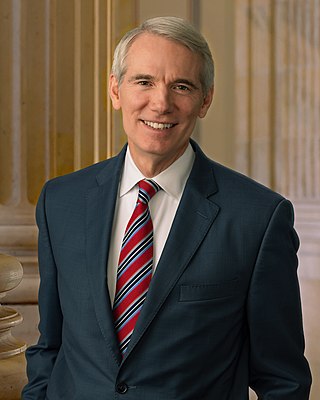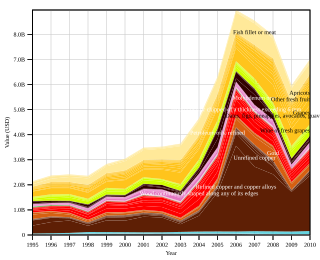Enactment and history
Congress started the fast track authority in the Trade Act of 1974, § 151–154 (19 U.S.C. § 2191–2194). This authority was set to expire in 1980, but was extended for eight years in 1979. [7] By that grant of authority and procedure, Congress then enacted implementing legislation for the U.S.-Israel Free Trade Area and the U.S.-Canada Free Trade Agreement. TPA authority was renewed from 1988 to 1993 to allow for negotiation of the North American Free Trade Agreement (NAFTA), and the commencement of the Uruguay Round, of the General Agreement on Tariffs and Trade (GATT). [8] With this grant of authority, Congress eventually enacted legislation implementing NAFTA. TPA authority was then further extended to April 16, 1994, [9] [10] [11] the day after the Uruguay Round concluded in the Marrakech Agreement, transitioning GATT into the World Trade Organization (WTO). Under this authority, Congress ultimately passed the implementing legislation for the Uruguay Round Agreements Act.
In the second half of the 1990s, fast track authority languished due to opposition from House Republicans. [12] Republican Presidential candidate George W. Bush made fast track part of his campaign platform in 2000. [13] In May 2001, as president he made a speech about the importance of free trade at the annual Council of the Americas in New York, founded by David Rockefeller and other senior U.S. businessmen in 1965. Subsequently, the Council played a role in the implementation and securing of TPA through Congress. [14]
At 3:30 a.m. on July 27, 2002, the House passed the Trade Act of 2002 narrowly by a 215 to 212 vote with 190 Republicans and 27 Democrats making up the majority. The bill passed the Senate by a vote of 64 to 34 on August 1, 2002. The Trade Act of 2002, § 2103–2105 (19 U.S.C. § 3803–3805), extended and conditioned the application of the original procedures. Under the second period of fast track authority, Congress enacted implementing legislation for the U.S.–Chile Free Trade Agreement, the U.S.–Singapore Free Trade Agreement, the Australia–U.S. Free Trade Agreement, the U.S.–Morocco Free Trade Agreement, the Dominican Republic–Central America Free Trade Agreement, the U.S.–Bahrain Free Trade Agreement, the U.S.–Oman Free Trade Agreement, and the Peru–U.S. Trade Promotion Agreement. The authority expired on July 1, 2007. [15]
In October 2011, the Congress and President Obama enacted into law the Colombia Trade Promotion Agreement, the South Korea–U.S. Free Trade Agreement, and the Panama–U.S. Trade Promotion Agreement using fast track rules, all of which the George W. Bush administration signed before the deadline. [16] By 2013, the majority of United States free trade agreements were implemented as congressional-executive agreements. [17] Unlike treaties, such agreements only require a majority of the House and Senate to pass. [17] Under the TPA, Congress authorizes the President to negotiate "free trade agreements ... if they are approved by both houses in a bill enacted into public law and other statutory conditions are met." [17]
TPP and 2015 reauthorization

In early 2012, the Obama administration indicated that renewal of the authority was a requirement for the conclusion of Trans-Pacific Partnership (TPP) negotiations, which had been undertaken as if the authority were still in effect. [18] In December 2013, 151 House Democrats signed a letter written by Rosa DeLauro (D-CT) and George Miller (D-CA), which opposed the fast track trade promotion authority for the TPP. Several House Republicans opposed the measure on the grounds that it empowered the executive branch. In January 2014, House Democrats refused to put forward a co-sponsor for the legislation, hampering the bill's prospects for passage. [19] On 16 April 2015, several U.S. Senators introduced "The Bipartisan Congressional Trade Priorities and Accountability Act of 2015", which is commonly known as TPA Fast-track legislation. [20] The bill passed the Senate on 21 May 2015, by a vote of 62 to 38, with 31 Democrats, five Republicans and both Independents opposing. [21] [22] The bill went to the U.S. House of Representatives, which narrowly passed the bill 218–208, and also removed the Trade Adjustment Assistance portions of the Senate bill. [23] The TPA was passed by the Senate on 24 June 2015, without the TAA provisions, requiring only the signature of the President before becoming law. [24] [25] President Obama expressed a desire to sign the TPA and TAA together, [26] and did sign both into law on 29 June, as the TAA was able to make its way through Congress in a separate bill. [27] The TPA law is known as the Bipartisan Congressional Trade Priorities and Accountability Act of 2015, [28] and the TAA law is known as the Trade Preferences Extension Act of 2015. [29]
The ultimate approval of this legislation conferred on the Obama administration "enhanced power to negotiate major trade agreements with Asia and Europe." Through the TPA, Obama could "submit trade deals to Congress for an expedited vote without amendments." [24] The successful conclusion of these bilateral talks was necessary before the other ten TPP members could complete the trade deal. [30]







